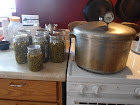Hello, Hello! How's everyone doing? We're good here. Have some kittens needing homes due to a feral mama and her brood we're housing. She's due to get fixed end of October, but she has 5 little babies needing a new place to live. Garden clean up is in the works. Putting the garden to bed is hard work, but very satisfying, especially if it's been a good year; and it has. I'll be behind the sewing machine adding stock to my Esty store soon. The holidays are on the horizon and I need to have a lot of doll clothes for gifts. Gifts for children, and gifts for people that are children at heart. Many of my customers are doll collectors. Weather it's due to nostalgia from their childhood, or they just happen to have an antique doll that needs dressing; those customers prefer the vintage style of the clothes I create. Child or child at heart, I got it covered.
I can understand the attraction. I too have dolls from my childhood. Being 56, those dolls are now bordering on antique, but definitely vintage. I also have a few old, old dolls, around 80-100 years old, and they need clothes too. I don't collect, these are just ones I use for models or am refinishing to find new homes. Have to include a recent restoration in this post. She's about 80 years old. I'm guessing you can tell the before and after. She's up for adoption to anyone interested. She's $75.
Vintage items are attractive, and in a practical sense, can be a really good buy. They're really a great choice when it comes to small home appliances. In some cases, large home appliances. I know. It sounds weird, but it's true. At the risk of sounding cliché, things were just made better then. My mom once told me people would know how long a couple had been married by the age of their appliances. I guess the same can be said these days, but for an entirely different reason. Appliances, then lasted way longer. They were built to last longer.
I was in an antique store a while back and saw a old Westinghouse stove similar to the one below. 1928! I was told by the dealer that the stove was still working the day it was taken out of the original owners house a week prior.
I myself recently lost my Iron. That iron, purchased at Walmart and from a allegedly reputable company, gave me fits from day 1. Being a seamstress; especially one who has a shop needing stocking, I needed an iron that would be a work horse. This one wasn't. It gave out after only a few years. I know I could have returned it right after I bought it, but I didn't have time. I needed an iron. So when this iron went out I knew I wanted to look vintage. I found a vintage GE steam and dry iron made in the 1970's. I've had it now for 14 months and it's been wonderful! It cost me $26. I did pay for priority shipping because I was in the middle of a custom order and was on the clock, but even that only made my total, taxes and everything, about $45. This iron is one purchase I know I don't regret.
I used my grandmothers pressure canner, manufactured in 1946, up until this year. This year I noticed a small crack in the bottom. This makes it unsafe to use as a pressure canner. 77 years old! I still have it though. Cant bring myself to throw it away.
The vast majority of my cookware is cast iron. I have a few new pieces, but prefer the old pre 1960 pieces. In a side by side comparison, the older cast iron seasons easier, and is lighter than it's modern day counterpart. Not to mention I love the history behind each pan/pot. To get these sometimes means restoring them from a rusted clump, but this isn't too hard. Many times a good scrub with vinegar and 0000 steel wool does the trick, but for really bad ones you can put them in your oven and set your oven to the self cleaning mode. Let the cleaning mode run it's course and you'll remove a good as new pot that just needs re-seasoning. While most of my cast iron is around the 1920-1940 era, I do have a couple that are late 1800's. Those were my great great grandmothers. I cherish those. The piece seen below was a mess of rust. I restored that one using electrolysis. An engineering friend helped me with that one. Basically it was submerged in salted water and a current was run through the water. The rust followed the current away from the pot. Not sure of all the scientific particulars, but that's the jest. I then washed and seasoned the pot. This pot is actually a humidifier.
I'll find vintage cooking utensils; knives, spatula, ladle's at thrift stores that hold up better than current "high quality" brands. My washing machine is an older gear driven machine. Makes it easier to repair if needed, and runs great.
The benefit of looking to vintage brands is the opportunity to get a product that works better at the same, if not lower, cost. I'll tell you there isn't one vintage item I own that I regret purchasing. Plus I love the idea of giving something old a new life.
Do you have any favorite trinkets? I'd love to hear about them.








